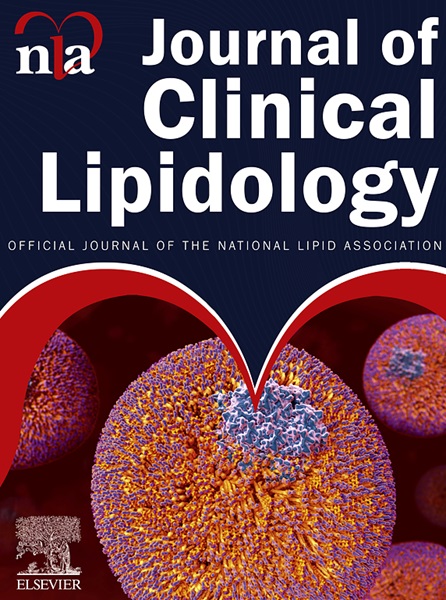肝移植对 14 名同型家族性高胆固醇血症患儿的治疗效果:前瞻性队列:家族性高胆固醇血症的肝移植。
IF 3.6
3区 医学
Q2 PHARMACOLOGY & PHARMACY
引用次数: 0
摘要
目的杂合子家族性高胆固醇血症(HoFH)的特点是低密度脂蛋白胆固醇(LDL-C)升高和早发心血管疾病。为了评估肝移植(LT)对HoFH患者的治疗效果,我们观察并分析了HoFH患儿接受LT后的预后。研究设计这项前瞻性队列研究纳入了2017年11月至2021年7月期间在仁济医院确诊为HoFH的所有18岁以下LT候选者。患者随访至 2023 年 10 月。他们按照本中心的标准方案接受治疗。我们收集了不同时间点的血脂变化、临床表现和心血管并发症的数据,并记录了术后受体和移植物存活率。结果纳入了14例HoFH患者,中位年龄为7(2-12)岁。术前分别有14名和3名患者出现黄瘤和角膜弧,10名患者有轻度心血管疾病。所有患者都接受了角膜移植术。中位随访时间为35(27-71)个月,受体和移植物存活率均为100%。中位 LDL-C 水平从术前的 11.83 (7.99-26.14) mmol/L 降至术后最后一次测量时的 2.3 (1.49-3.39) mmol/L。13名患者在LT术后停止了降脂治疗,只有一名患者在术后6个月恢复了他汀类药物治疗。黄瘤和角膜弧明显改善。结论LT是一种安全有效的治疗方法,适用于无法控制血脂的重度HoFH患者。早期LT可改善预后和生活质量,同时将心血管并发症的风险降至最低。本文章由计算机程序翻译,如有差异,请以英文原文为准。
The therapeutic effect of liver transplantation in 14 children with homozygous familial hypercholesterolemia: a prospective cohort: Liver transplant for familial hypercholesterolemia.
OBJECTIVES
Homozygous familial hypercholesterolemia (HoFH) is characterized by elevated low-density lipoprotein cholesterol (LDL-C) and early-onset cardiovascular disease. To assess the therapeutic effects of liver transplantation (LT) on HoFH patients, we observed and analyzed the outcomes of HoFH children after LT.
STUDY DESIGN
This prospective cohort study included all LT candidates under 18 years old diagnosed with HoFH at Ren Ji Hospital between November 2017 and July 2021. The patients were followed until October 2023. They were treated according to the standard protocol at our center. We collected data on changes in lipid profiles, clinical manifestations, and cardiovascular complications at different time points, and recorded postoperative recipient and graft survival.
RESULTS
Fourteen HoFH patients with a median age of 7 (2-12) years were included. Preoperatively, xanthomas and arcus corneas occurred in 14 and 3 patients, respectively, with 10 patients showing mild cardiovascular disease. All patients underwent LT. Recipient and graft survival rates were 100 % over a median follow-up duration of 35 (27-71) months. Median LDL-C levels dropped from 11.83 (7.99-26.14) mmol/L preoperatively to 2.3 (1.49-3.39) mmol/L postoperative at the last measurement. Thirteen patients discontinued lipid-lowering treatment after LT, while only one patient resumed statins 6 months post-operation. Xanthomas and arcus corneas significantly improved. Cardiovascular complications regressed in five patients, with no progression observed in the others.
CONCLUSIONS
LT is a safe and effective treatment for severe HoFH patients beyond lipid-lowering control. Early LT improves prognosis and quality of life while minimizing the risk of cardiovascular complications.
求助全文
通过发布文献求助,成功后即可免费获取论文全文。
去求助
来源期刊
CiteScore
7.00
自引率
6.80%
发文量
209
审稿时长
49 days
期刊介绍:
Because the scope of clinical lipidology is broad, the topics addressed by the Journal are equally diverse. Typical articles explore lipidology as it is practiced in the treatment setting, recent developments in pharmacological research, reports of treatment and trials, case studies, the impact of lifestyle modification, and similar academic material of interest to the practitioner.
Sections of Journal of clinical lipidology will address pioneering studies and the clinicians who conduct them, case studies, ethical standards and conduct, professional guidance such as ATP and NCEP, editorial commentary, letters from readers, National Lipid Association (NLA) news and upcoming event information, as well as abstracts from the NLA annual scientific sessions and the scientific forums held by its chapters, when appropriate.

 求助内容:
求助内容: 应助结果提醒方式:
应助结果提醒方式:


